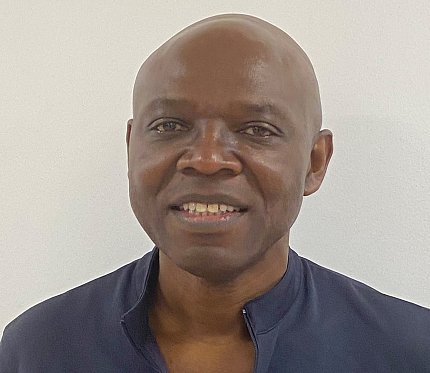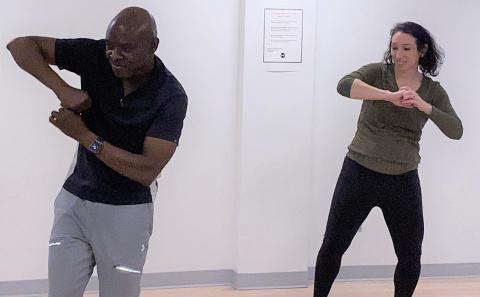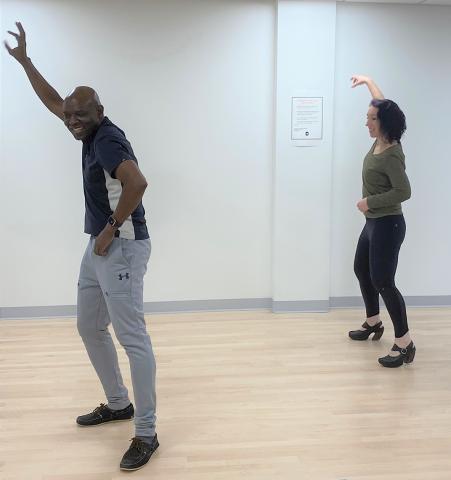NIH’er Teaches Afro-Cuban Dance for Fun, Health

It’s often said that physical activity is a key factor in creating and maintaining a healthy mind and body, but no one said that activity could not also be fun. Dr. Methode Bacanamwo of the Center for Scientific Review (CSR) takes this view to heart.
“People ask me how I stay in shape,” said Bacanamwo. “I tell them, ‘I dance’ and they should too! It’s enjoyable and has great health benefits at the same time.”
Bacanamwo has taught several classes in Afro-Cuban dance at the NIH Fitness Center at the Rockledge 2 Bldg. over the past two years. Through an engaging teaching manner, he demonstrated several moderate moves many can do easily, even if they have no prior dance experience.
Dance has been a large part of Bacanamwo’s life since he was very young, growing up in the East African country of Burundi, which has a rich drumming culture.

He came to the U.S. on a scholarship from the New York–based Africa-America Institute, a nonprofit organization providing educational opportunities for young people from Africa. He attained an M.S. in physiology from Clemson University and a Ph.D. in molecular genetics and biochemistry from the University of Illinois Urbana-Champaign. At each step along his career path, he has taken his love of dance and found he was not alone among his colleagues.
“In graduate school, my Ph.D. advisor, who is a great scientist in the field of biochemistry, is also a great ballroom dancer, along with his wife,” said Bacanamwo. “They would invite members of the lab to come watch the performances and learn a few dance steps.”
Already familiar with dance connected to African, twist and swing music, to name a few, Bacanamwo liked ballroom dancing so much that he got formal training in that style.
His first faculty job was in Atlanta at the Cardiovascular Research Institute (CVRI) at Morehouse School of Medicine. Atlanta has a large Caribbean population and, while living there, Bacanamwo was introduced to Cuban dancing, in some cases with African influences. He explained how he would attend dancing congresses where he would learn different types of Cuban dances and the history behind them.
At CVRI, he worked on drug-resistant hypertension, particularly among African Americans. He and his colleagues explored the adoption of the National Heart, Lung and Blood Institute’s DASH diet and other lifestyle changes as part of patient care.

“I gained an appreciation for the importance of lowering one’s stress levels and engaging in physical activity to improve one’s cardiovascular health,” said Bacanamwo. “And naturally I thought of dance.
“You cannot be stressed after listening and dancing to the music you like, and dancing is a form of physical activity,” he said, adding that Afro-Cuban dance, in particular, is very versatile. “You can apply it to many types of music that might interest you.”
Bacanamwo loves to teach dance whenever possible and explain its health benefits, noting that many people will take the time to learn something new when given the opportunity. His classes at the NIH Fitness Center have been well received, with many smiles and much laughter and exclamations of “That was fun!”
“When you do something that is enjoyable, you do not realize how quickly the time passes, despite having done so much,” he said, emphasizing how easy it can be to incorporate a fair amount of dance into one’s health routine.
“You do not need a fancy setup or other people to dance, and dancing does not have to be super strenuous,” he added. “You could be cooking and cleaning while doing moderate dance as well. You can even do some dance moves while sitting. Moving your body is the key.”
Bacanamwo hopes to hold more classes at the NIH Fitness Center. In the meantime, he continues to share his love of dance and encourage others to consider making it a part of their healthy habits.
To learn more about Cuban dance communities in the area and related classes, see: https://www.dccasineros.org/.
“If I could inspire everyone to get into dancing, I would,” he said. “We would begin to see great improvements in people’s health and well-being.”
